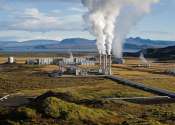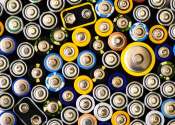Energy & Green Tech news
Energy & Green Tech
Mechanistic understanding could enable better fast-charging batteries
Fast-charging lithium-ion batteries are ubiquitous, powering everything from cellphones and laptops to electric vehicles. They're also notorious for overheating or catching fire.
Apr 5, 2025
0
33
Energy & Green Tech
Burning heavy fuel oil with scrubbers found to be the best available option for bulk maritime shipping
When the International Maritime Organization enacted a mandatory cap on the sulfur content of marine fuels in 2020, with an eye toward reducing harmful environmental and health impacts, it left shipping companies with several ...
Apr 4, 2025
0
21

Single-atom catalysts transform hydrogenation, improving food and fuel production
A chemical reaction that's vital to a range of commercial and industrial goods may soon be initiated more effectively and less expensively thanks to a collaboration that included Oregon State University College of Engineering ...
Apr 4, 2025
0
0

Report: Energy leaders present six big ideas to help avoid US electricity crisis
After about 20 years of scant growth, U.S. electricity demand is expected to grow about 15-20% in the next decade and double by 2050, according to the Department of Energy. In light of these predictions, more than 80 U.S. ...
Apr 4, 2025
0
2

Cuba looks to sun to solve its energy crisis
Not far from the ruins of an unfinished nuclear power plant in the Cuban province of Cienfuegos, hundreds of workers are hastily installing 44,000 solar panels as the island seeks once again to reduce its reliance on oil ...
Apr 4, 2025
0
1
Energy & Green Tech
With affordable materials, researchers pull carbon directly from the air using changes in humidity
Researchers at Northwestern University have expanded the potential of carbon capture technology that plucks CO2 directly from the air by demonstrating that there are multiple suitable and abundant materials that can facilitate ...
Apr 3, 2025
0
105
Energy & Green Tech
Strain 'trick' improves perovskite solar cells' efficiency
Researchers at EPFL have found a way to dramatically reduce energy loss and boost efficiency in perovskite solar cells by incorporating rubidium using lattice strain—a slight deformation in the atomic structure that helps ...
Apr 3, 2025
0
0
Energy & Green Tech

Dangerous by design: Runaway miniature battery makes safety testing more accessible and affordable
Overheating batteries are a serious risk, in the worst cases leading to fires and explosion. A team including researchers from the University of Tokyo has developed a simple, cost-effective method to test the safety of lithium-ion ...
Apr 3, 2025
0
22
Engineering

Recycling wind turbine blade materials to make improved plastics
A new method to recycle wind turbine blades without using harsh chemicals resulted in the recovery of high-strength glass fibers and resins that allowed Washington State University researchers to repurpose the materials to ...
Apr 3, 2025
0
13
Energy & Green Tech

New coal capacity hit 20-year low in 2024: report
The world added the smallest amount of new coal capacity in two decades last year, a report said Thursday, but use of the fossil fuel is still surging in China and India.
Apr 3, 2025
0
11
Energy & Green Tech

Carbon-capture technology could help the UK rival global competitors in race to produce clean fuel from air
A unique carbon capture technology developed by researchers at the University of Surrey could offer a more cost-effective way to remove carbon dioxide (CO2) from the air and turn it into clean, synthetic fuel.
Apr 3, 2025
0
3
Engineering

Scientists create 'fungi tiles' with elephant skin texture to cool buildings
A team of scientists led by Nanyang Technological University, Singapore (NTU Singapore) have developed "fungi tiles" that could one day help to bring the heat down in buildings without consuming energy.
Apr 2, 2025
0
40
Energy & Green Tech

Redox flow battery achieves energy efficiency of 87.9% and longer cycling life with new catalytic electrode
A team of materials scientists, chemical engineers, and environmental scientists affiliated with a host of institutions in China has developed a redox flow battery (RFB) with 87.9% energy efficiency, which can also last for ...
Energy & Green Tech

Study reveals chromium's role in molten salt reactor corrosion
High temperatures and ionizing radiation create extremely corrosive environments inside a nuclear reactor. To design long-lasting reactors, scientists must understand how radiation-induced chemical reactions impact structural ...
Apr 2, 2025
0
11
Engineering

Turning wastewater into a resource: Advanced filtration tackles water scarcity challenges
With global water scarcity on the rise—impacting 38% of Europe's population in 2019 alone—a novel approach is emerging to transform wastewater into a valuable resource. Water-smart industrial symbioses (WSISs) offer an ...
Apr 2, 2025
0
0
Energy & Green Tech

Scientists investigate soil as a thermal energy storage solution
When spring arrives and the heating season comes to an end, keeping warm becomes less of an issue. However, scientists remind us that it is not just a seasonal necessity—heat is also a valuable energy resource that can ...
Apr 2, 2025
0
0
Energy & Green Tech

Converting the forest industry's carbon dioxide emissions into raw material for plastics
VTT Technical Research Center of Finland and LUT University have completed a three-year research project on carbon capture and utilization. The project investigated different technologies for producing renewable plastic raw ...
Apr 2, 2025
0
0
Energy & Green Tech

Coal-fired power plant, now retired, to become massive gas-powered campus for AI, data centers
The owners of what was once Pennsylvania's biggest coal-fired power plant said Wednesday that they will turn it into a $10 billion natural gas-powered data center campus designed to capitalize on the fast-growing energy demands ...
Apr 2, 2025
0
0
Engineering

Highly twisted metamaterial rods store large amounts of energy
An international research team coordinated at KIT (Karlsruhe Institute of Technology) has developed mechanical metamaterials with a high elastic energy density. Highly twisted rods that deform helically provide these metamaterials ...
Apr 1, 2025
0
37
Energy & Green Tech

Charging electric vehicles 5x faster in subfreezing temps
A modified manufacturing process for electric vehicle batteries, developed by University of Michigan engineers, could enable high ranges and fast charging in cold weather, solving problems that are turning potential EV buyers ...
Apr 1, 2025
0
27
Engineering

Diagnosing a dud may lead to a better battery
A team of chemists led by Feng Lin and Louis Madsen found a way to see into battery interfaces, which are tight, tricky spots buried deep inside the cell. The research findings were published in the journal Nature Nanotechnology.
Apr 1, 2025
0
35
Engineering

Stronger, lighter, cheaper: Enhancing carbon fiber production with low-cost oil residues
Advanced carbon fiber materials could be used in applications from wind turbine blades to biomedical implants following the development of a low-cost carbon fiber feedstock.
Apr 1, 2025
0
37
Energy & Green Tech

Susceptible organic cations promote stability and efficiency in perovskite solar cells
Unlike conventional silicon-based solar cells, perovskite solar cells (PSCs) are not only thin and lightweight, but can also be seamlessly applied to curved surfaces, like building facades and vehicle roofs. What's more, ...
Apr 1, 2025
0
41
Energy & Green Tech

Hotter and deeper: How NZ's plan to drill for 'supercritical' geothermal energy holds promise and risk
New Zealand's North Island features a number of geothermal systems, several of which are used to generate some 1,000 MegaWatts of electricity. But deeper down there may be even more potential.
Apr 1, 2025
0
7
Energy & Green Tech

Bio-based technology successfully recovers up to 95% of high-purity lithium from spent batteries
A microbial electrochemical technology capable of recovering 90%–95% of lithium from spent lithium-ion batteries has been developed by scientists at the University of Surrey. The breakthrough offers a more sustainable and ...
Apr 1, 2025
0
0







































